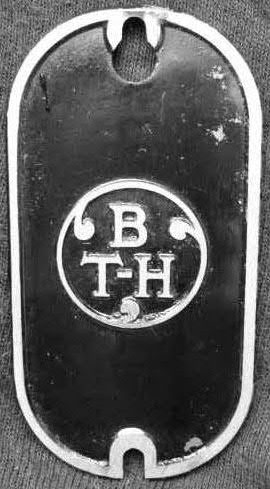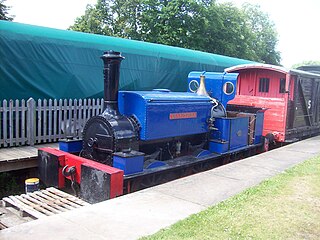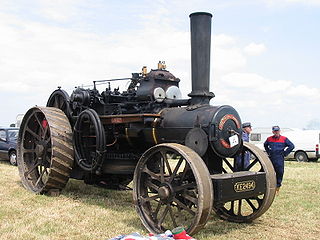
Under the Whyte notation for the classification of steam locomotives, 0-4-0 represents one of the simplest possible types, that with two axles and four coupled wheels, all of which are driven. The wheels on the earliest four-coupled locomotives were connected by a single gear wheel, but from 1825 the wheels were usually connected with coupling rods to form a single driven set.

British Thomson-Houston (BTH) was a British engineering and heavy industrial company, based at Rugby, Warwickshire, England. Originally founded to sell products from the Thomson-Houston Electric Company, it soon became a manufacturer using licences from the American company. They were known primarily for their electrical systems and steam turbines.
Brush Traction was a manufacturer and maintainer of railway locomotives in Loughborough, England whose operations have now been merged into the Wabtec company's Doncaster UK operations.

HS4000 Kestrel was a prototype high-powered mainline diesel locomotive that was built in 1967 by Brush Traction, Loughborough, as a technology demonstrator for potential future British Rail and export orders. The locomotive number is a combination of the initials of Hawker Siddeley and the power rating of its Sulzer diesel engine (4,000 hp), making it the most powerful locomotive built by the company.

Sentinel Waggon Works Ltd was a British company based in Shrewsbury, Shropshire that made steam-powered lorries, railway locomotives, and later, diesel engined lorries, buses and locomotives.

The Yorkshire Engine Company (YEC) was a small independent locomotive manufacturer in Sheffield, England. The company was formed in 1865 and produced locomotives and carried out general engineering work until 1965. It mainly built shunting engines for the British market, but also built main line engines for overseas customers.

W. G. Bagnall was a locomotive manufacturer from Stafford, England which was founded in 1875 and operated until it was taken over in 1962 by English Electric.

Motor Rail was a British locomotive-building company, originally based in Lewes, Sussex, they moved in 1916 to Bedford. Loco manufacture ceased in 1987, and the business line sold to Alan Keef Ltd of Ross-on-Wye, who continue to provide spares and have built several locomotives to Motor Rail designs.

Manning Wardle was a steam locomotive manufacturer based in Hunslet, Leeds, West Yorkshire, England.

The Avonside Engine Company was a locomotive manufacturer in Avon Street, St. Philip's, Bristol, England between 1864 and 1934. However the business originated with an earlier enterprise Henry Stothert and Company.
Dick, Kerr and Company was a locomotive and tramcar manufacturer based in Kilmarnock, Scotland and Preston, England.

John Fowler & Co Engineers of Leathley Road, Hunslet, Leeds, West Yorkshire, England produced traction engines and ploughing implements and equipment, as well as railway equipment. Fowler also produced the Track Marshall tractor which was a tracked version of the Field Marshall. British Railways Engineering Department locomotives ED1 to ED7 were built by Fowler
Muir Hill (Engineers) Ltd was a general engineering company based at Old Trafford, Manchester, England. It was established in the early 1920s and specialised in products to expand the use of the Fordson tractor, which in the pre-war days included sprung road wheels, bucket loaders, simple rail locomotives, and in particular in the 1930s they developed the dumper truck. Later they built high horse power tractors.
The Drewry Car Co was a railway locomotive and railcar manufacturer and sales organisation from 1906 to 1984. At the start and the end of its life it built its own products, for the rest of the time it sold vehicles manufactured by sub-contractors. It was separate from the lorry-builder, Shelvoke & Drewry, but it is believed that James Sidney Drewry was involved with both companies.

Thomas Green & Son, Ltd. were engineers who manufactured a wide range of products at the Smithfield Foundry, Leeds, United Kingdom

The Eigiau Tramway might refer to the Eigiau Quarry Tramway or to the Eigiau Reservoir Tramway.

A trench railway was a type of railway that represented military adaptation of early 20th-century railway technology to the problem of keeping soldiers supplied during the static trench warfare phase of World War I. The large concentrations of soldiers and artillery at the front lines required delivery of enormous quantities of food, ammunition and fortification construction materials where transport facilities had been destroyed. Reconstruction of conventional roads and railways was too slow, and fixed facilities were attractive targets for enemy artillery. Trench railways linked the front with standard gauge railway facilities beyond the range of enemy artillery. Empty cars often carried litters returning wounded from the front.
W.H. Dorman & Co was a company formed by William Henry Dorman in 1870 making cutting tools for the footwear industry. It diversified into other tools including grinders, and in 1903 into internal combustion engines. This was to be its main product up to the point where it was taken over by the English Electric Company in 1961, though the Dorman name continued as a diesel engine trademark until 1995. William Henry Dorman retired in 1911, and died in 1926.

The South African Railways Dutton road-rail tractors of 1923 were road-rail steam tractors.
Kent Construction and Engineering Co Ltd of Victoria Works, Victoria Road, Ashford, Kent are best known for purchasing many former World War I War Department Light Railway locomotives at the end of the war, both narrow-gauge and standard gauge, and reselling them after repair/reconditioning using the "Planet" trademark. It went on to design its own locomotives, and one of the new designs was shown at the Public Works, Roads & Transport Exhibition at Islington in November 1925 by Honeywill Brothers.
















